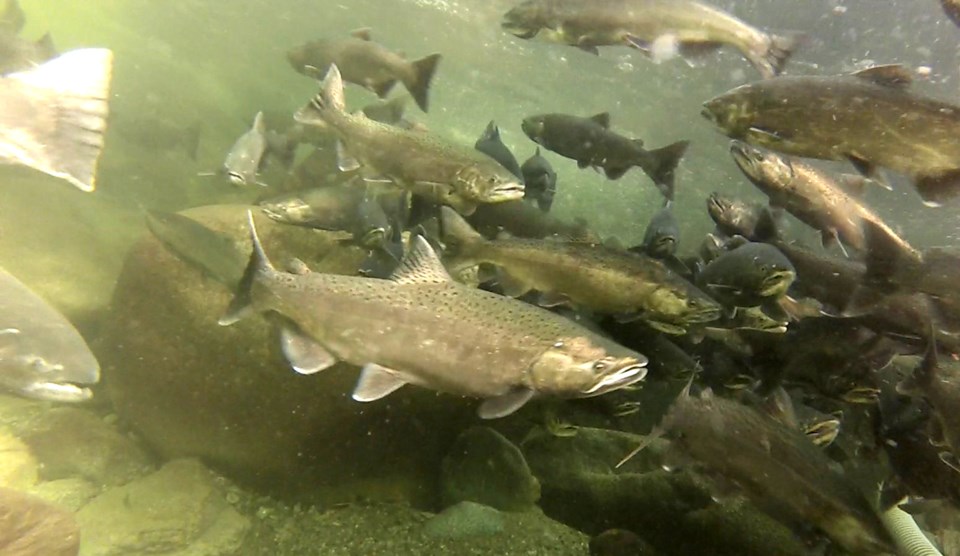It is tough to be a salmon these days.
Salmon, of course, are born in fresh water, migrate to the ocean and return to fresh water to reproduce.
Problem number one for salmon is that freshwater streams are drying up.
Professional biologist and Squamish River Watershed Society executive director Edith Tobe said she has never seen it this dry in June and July.
“In the headwaters, there is next to no water feeding into the tributaries,” said Tobe. “We’ve seen that on Mount Garibaldi, we’ve seen Shannon Falls is running dry and we’ve seen it on the Tantalus Range now.”
On July 15, the province declared the Lower Mainland, including the corridor, to be in a stage 4 drought, meaning conditions are extremely dry.
“Low flows mean less total habitat in streams and rivers, which for the salmon and trout means less spawning areas, and less area to produce food, like small invertebrates, for young fish,” said John Richardson, professor and head of department of forest and conservation sciences at UBC.
In low-flowing streams, fish also have a harder time escaping predators and less water heats up quicker, according to Richardson.
“And that can put most of our coldwater and cool water species like salmon, trout and chars into serious conditions that can lead to death.”
The second problem for the salmon is warmer ocean temperatures.
The ocean temperatures are currently the warmest seen in the east sub-Arctic Pacific since 1948, according to Ian Perry, research scientist with the Canadian Department of Fisheries and Oceans (DFO).
The warm ocean conditions started in the fall of 2013 in the northeast Pacific.
“By the time January 2014 arrived, we had record high temperatures,” Perry said, adding sea surface temperatures were about three degrees or more above normal. In the summer of 2014, normal winds returned and blew all of that warm water to the coast of North America. “By the time we reach the October of 2014 and through to today, actually we had very high temperatures along the coast of B.C. and in some places record high temperatures.”
With warmer ocean temperatures there is less food available for salmon at sea, according to Richardson, “since their food species are also dependent on certain temperatures, so there have been large changes in the last year or so.”
The kinds of predators salmon face in the ocean have also changed: warmer water species are showing up further north, he said. Fish also use up more energy at warmer water temperatures, “apparently returning as smaller fish based on some test fisheries used to determine the condition of fish stocks,” Richardson said.
Salmon also have to deal with the impact of wildfires.
The hundreds of fires burning across B.C. and the five fires of note burning in the coastal area are bad news for salmon and other fish.
Some fires burn right up against a stream and burn away tree cover remove shading, which is an important barrier to keeping temperatures lower for salmon, according to Richardson. The fires also destroy the supply of large wood, like tree trunks, that fish like to hide under in streams and contribute to the erosion of sediments if the banks lose the roots that hold them in place, he said.
One positive offshoot of wildfires is increased nutrients reaching the steams since reduced tree cover means more erosion once we get rain, he said. But those increased nutrients only last a maximum of two years so the benefit is short-lived.
“All these things would suggest the fishes we mostly think about will have a terrible year, and there may be fewer [salmon] next generation,” Richardson said.
Finding solutions
Groups such as the Squamish Streamkeepers Society are doing what they can to help with fish trapped in dry streams.
“We capture them, we put them in buckets with aerators, and then we take the fry to another location where they will be able to survive,” said Streamkeeper Jack Cooley.
One of the areas where they take the fry is the top of Mashiter Creek spawning channel, where more water is available. “They will survive there,” he said.
John Weston, member of Parliament for West Vancouver-Sunshine Coast-Sea to Sky Country, said the federal government’s $2 million investment in the Pacific Salmon Foundations Salish Sea Marine Survival Project, which involves research into the decline of Coho and Chinook salmon, is an effort to address ocean warming and the threat to salmon.
“Eight million is coming from the private sector, and based on advocacy of British Columbians, we got $2 million to top that up,” he said.
Richardson said one solution is for governments to “climate proof” by ensuring there is more protection of small source streams that heat up quickly. Leaving more trees around streams can help. “Currently our government does not require protection of small source streams beyond keeping machinery out of them,” Richardson said.
Governments may also have to “limit exploitation of groundwater by commercial users, which can lower the water table, which means less water reaching the surface… our streams and rivers.”
The extent of some salmon runs this year won’t be known until August, according to Jeff Grout, regional salmon manager for DFO.
Conservation and sustainable use are the top priorities in managing fish stocks, he said.
Measures that are either currently being taken or could be enacted by the DFO include curtailed or delayed openings or closed fisheries, limits on harvest rates in some areas, and angling closures in some river systems.



